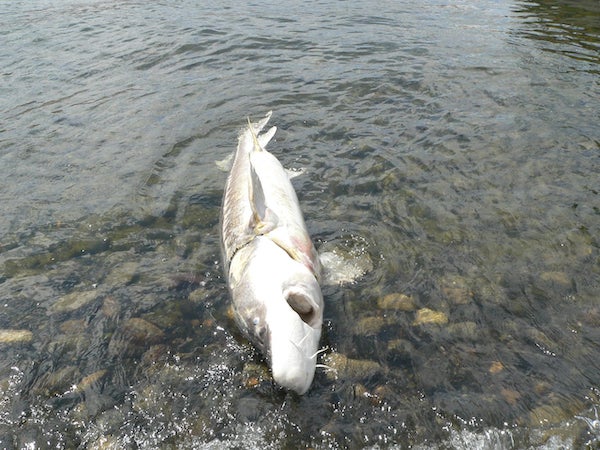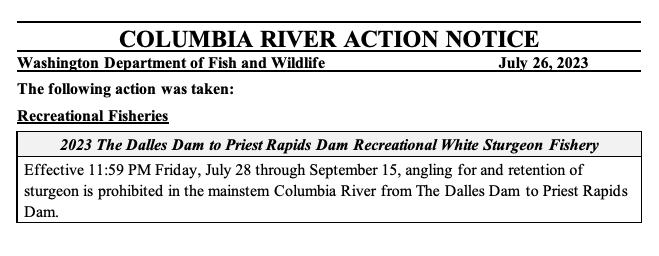
All Sturgeon Fishing To Close On Columbia From PRD To The Dalles
Editor’s note: Updated 10:25 a.m., July 27, 2023, with a WDFW link for where to report dead sturgeon, as well as quotes from the agency’s lead sturgeon biologist.
Columbia fishery managers are closing the big river for all sturgeon angling from The Dalles Dam upstream to Priest Rapids Dam starting this Saturday, July 29.

At least six dead sturgeon have been observed in the Hanford Reach and McNary Pool in the past week, according to WDFW biologist Paul Hoffarth in Tri-Cities, while ODFW reports there have been around 24 mortalities overall, mostly in the John Day Pool. Warm water temperatures are being blamed for the diefoff.
“High water temperatures and lower dissolved oxygen have been shown to stress and kill sturgeon. While only catch-and-release fishing is allowed this time of year, closing all fishing will help reduce stress from capture and handling and give sturgeon some relief until water temperatures cool off in September,” an ODFW press release states.

The angling ban includes catch-and-release fishing and is in place through September 15.
“Sturgeon are very hardy fish in a lot of ways, but they’re also very vulnerable to certain stressors, especially in the late spring and summer period after they spawn,” said Laura Heironimus, Washington’s lead sturgeon biologist, in a WDFW press release. “We see some sturgeon mortalities reported every year, but the number this year is higher than normal and in areas with lower abundances and recruitment concerns, and we want to give these fish every chance possible to survive.”
A large number of Mid-Columbia sturgeon also died in July 2015 following a heat wave that also wiped out a quarter of the sockeye returning up the river that summer.
WDFW is tracking this year’s losses and anglers and the public are being asked to report the locations of dead sturgeon at the agency’s Fish and Shellfish Carcass Reporting Form.
“We definitely want to know about any additional mortalities and encourage anyone who finds a dead sturgeon to use the reporting tool,” said Heironimus. “Fortunately, we are seeing fewer adult-size sturgeon mortalities than what was observed during the drought of 2015, but we’ll continue monitoring for the rest of the summer.”
Hoffarth notes that dead sturgeon that have already been sampled by WDFW and ODFW will have had the upper half of their tail fin removed.
